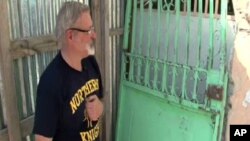Amid the loss and horror that surrounded the earthquake in Haiti a year ago there are positive stories of triumph over tragedy. Several days after the earthquake, VOA's Jeff Swicord met Michael Geilandfeld, an American who runs a house for former child slaves and street children. While the house was heavily damaged by the quake, Geilandfeld vowed to carry on with his work. We stopped by to see how he was doing in the new year.
"This painting really depicts a child who is in struggle and feeling alone and lost," explained Michael Geilanfeld, who runs St. Joseph's, a house for former child slaves and street children in Port au Prince. That was Michael a year ago, a few days after the devastating earthquake of January 12.
"So this is the house the children were in," Geilanfeld continued. The house and neighboring facilities were heavily damaged. The children had to be moved to the safety of the countryside.
Counting blessings
Today, Michael Geilanfeld counts himself and the St. Joseph's community lucky. Last year at this time, the quake hit just as they were about to celebrate their 25th anniversary.
"We were having 250 people come for this anniversary celebrations from all over the United States and Canada. So we had painted the house, put up new curtains. The house looked as best it has ever looked. So, less than two weeks before that celebration, it all came down," he recalled.
Progress
A year later, thanks to the generosity of donors from abroad, St. Joseph's is rebuilding. The orphanage bought and moved into the house next door. An architect has donated his time to rebuild the old house, and insisted the footings be dug extra deep. Other precautions will be taken to ensure the house can withstand another earthquake.
The children have returned. Twenty-two boys live at St. Joseph's; most attend this school around the corner. Fijnole, 17, has lived in the house since he was three. His parents could not afford to care for him. He says going to school is something he never imagined when he was younger.
"It is a good thing for me because now I can go to school and I can lift up my parents. My dream is to lift my parents where they are. To helping them as much as I can," Fignole said.
Helping hands
Exza, 17, has been helping out with the new construction. Exza came to St. Joseph's after the earthquake, and says without the safety and security it provides, the last year could have turned out very differently.
"It was a good year for me because after the earthquake we had a hurricane and then a cholera epidemic. But I was not affected and I am safe, so it has been a good year," Exza said.
Aid groups say it's impossible to know how many children were orphaned by the earthquake, but USAID estimates the number to be at least 15,000 - with as many or more losing their main care-giver. So far, UNICEF has only re-united a few thousand children with their families.
Lasting effects
At St. Joseph's, Michael says the quake was traumatic for all of the children.
"Just going through the earthquake, the shaking, and all of our guys would tell you that they thought it was the end of the world. They thought everything was going away for good. And if a car drives by and the building shakes, they would all run," he said.
Michael has not forgotten the tragedy most Haitians have experienced. He has hung this painting in the house - depicting a tent city - as a tribute to the resilience of the Haitian people.
"They have been reduced to this living under trees and living under tarps, and yet life goes on. They make the best of what they are doing. But it is a struggle because they are living day by day," he said.
Optimism
A year ago, this mural at the entrance of the building was destroyed. Now, Michael is typically optimistic about the loss.
"But we can repaint, right? we can rebuild. What we celebrate is we didn't lose any of the children. They would not be able to be replaced. So, all the material things are not important," he said.
Once the original house is restored, Michael Geilandfeld plans to build three new buildings on the neighboring property he has acquired.












